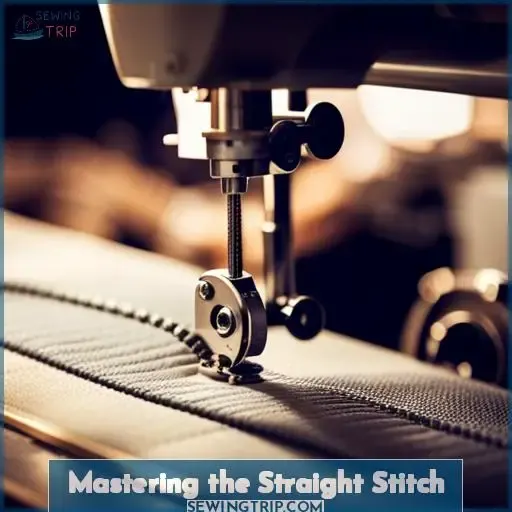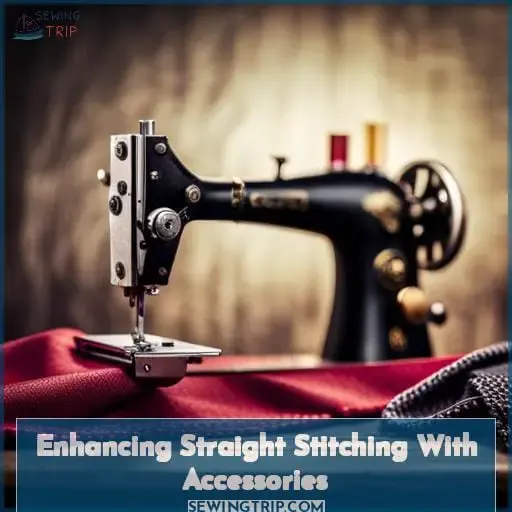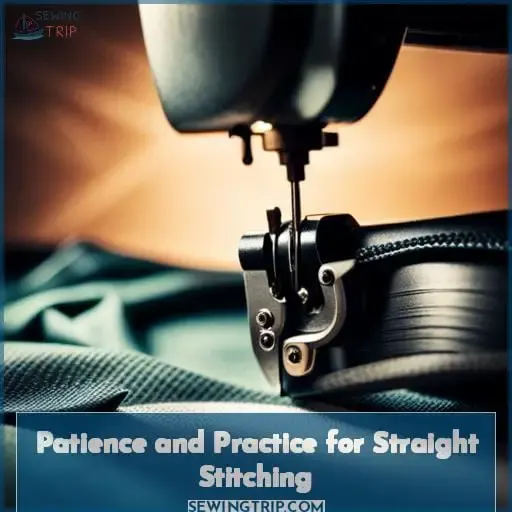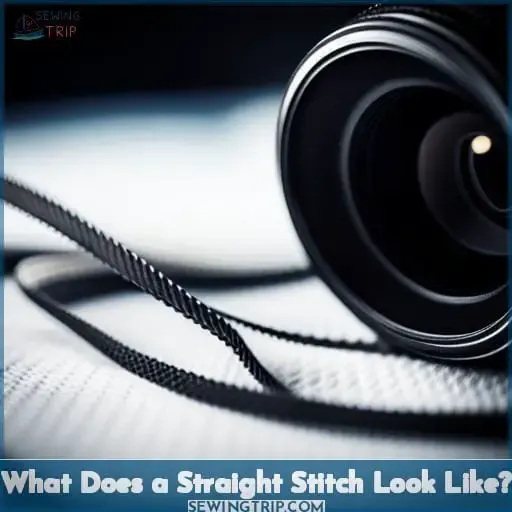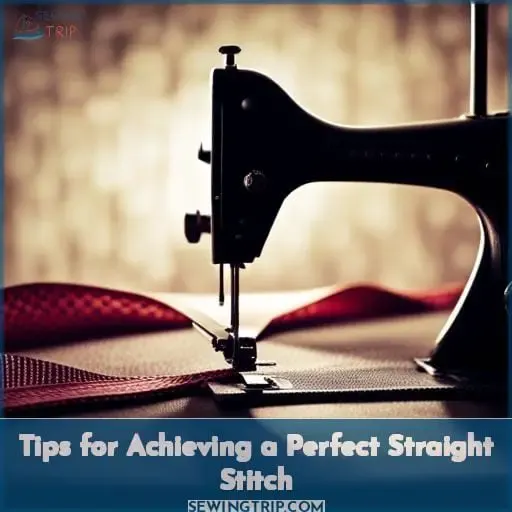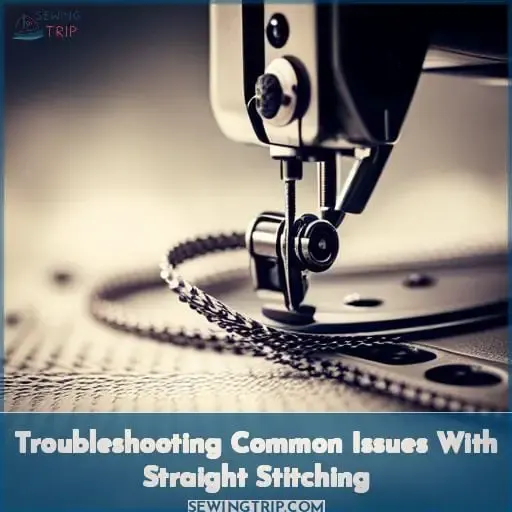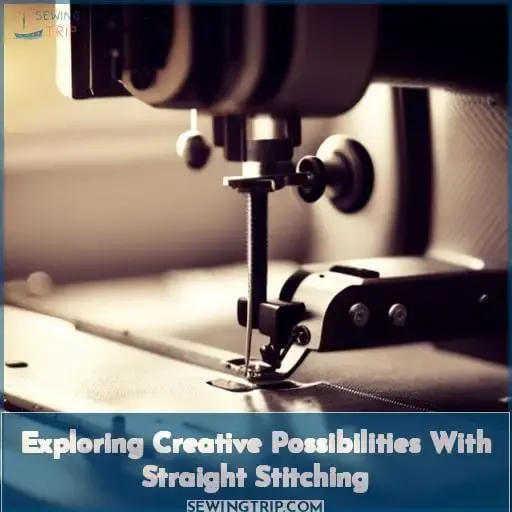This site is supported by our readers. We may earn a commission, at no cost to you, if you purchase through links.
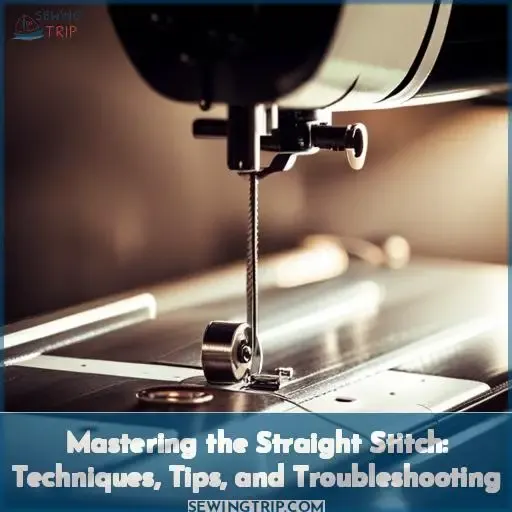 Ready to take your sewing skills to the next level? In this article, you’ll master the art of straight stitching on a sewing machine. From techniques and tips for achieving perfect stitches every time, to troubleshooting common issues that may arise, we’ve got you covered.
Ready to take your sewing skills to the next level? In this article, you’ll master the art of straight stitching on a sewing machine. From techniques and tips for achieving perfect stitches every time, to troubleshooting common issues that may arise, we’ve got you covered.
Whether you’re a beginner or an experienced sewist looking for some extra guidance, this comprehensive guide will help you become a straight stitch pro in no time.
Straight Stitching Basics
The straight stitch is the most basic and essential stitch in sewing. It is used to join two pieces of fabric together, create hems, and make other basic sewing projects.
- A sewing machine
- Thread
- Fabric
- A needle
- A thimble
Instructions:
- Use a walking foot to help prevent your fabric from puckering.
- Use a stabilizer to help prevent your fabric from stretching.
- Use a needle threader to help you thread your needle more easily.
- Use a seam ripper to remove stitches that you don’t like.
With a little practice, you’ll be able to sew perfect straight stitches in no time!
Table Of Contents
- Key Takeaways
- Mastering the Straight Stitch
- Techniques for Straight Stitching
- Enhancing Straight Stitching With Accessories
- Patience and Practice for Straight Stitching
- What Does a Straight Stitch Look Like?
- Step-by-Step Guide for Sewing a Straight Stitch
- Tips for Achieving a Perfect Straight Stitch
- Troubleshooting Common Issues With Straight Stitching
- Exploring Creative Possibilities With Straight Stitching
- Frequently Asked Questions (FAQs)
- Conclusion
Key Takeaways
- Straight stitching offers numerous benefits in sewing projects.
- There are various options for seam allowance when straight stitching.
- Quilting can be done effectively using a straight stitch machine.
- Mastering straight stitching requires patience and practice.
Mastering the Straight Stitch
Now that you have familiarized yourself with the key features and functionalities of a straight stitch machine, let’s delve into mastering the straight stitch itself.
In this section, we’ll explore the benefits of straight stitching, different options for seam allowances, and how to effectively use a straight stitch machine for quilting projects. By understanding these points and implementing them in your sewing practice, you’ll be well on your way to becoming a master at creating clean and precise straight stitches.
Benefits of Straight Stitching
One of the key benefits of straight stitching is its versatility in providing a clean and precise seam for various sewing projects.
Whether you’re creating garments, home decor items, or quilts, the straight stitch offers impeccable results.
It’s an essential sewing technique that can be easily achieved using a standard sewing machine with proper needle position and fabric support.
Seam Allowance Options
Choose your desired seam allowance with precision and confidence when mastering the straight stitch.
Whether you prefer a narrow or wide seam, adjusting the width is crucial for achieving professional results.
Consider factors such as fabric thickness and edge finish to determine the ideal seam allowance.
Utilize tools like seam guides or reference points on your machine to ensure accuracy in stitching.
Quilting With a Straight Stitch Machine
If you’re quilting with a straight stitch machine, enhance your control and precision by using the appropriate presser foot.
Selecting the right presser foot for quilting designs is crucial to achieving professional results.
Consider fabric selection, basting methods, thread tension, and binding techniques for successful quilt stitching.
Explore additional tools like laser guides or seam guide attachments to further improve your straight stitching skills on a sewing machine.
Techniques for Straight Stitching
To master the art of straight stitching, focus on key techniques that will enhance your precision and consistency.
Avoid fixating on the needle movement; instead, divert your attention to a fixed point near the presser foot for stability.
Maximize fabric control by leveraging the machine’s feed dogs and providing ample support for your fabric.
Additionally, utilize reference points such as seam guide markings or presser foot edges to ensure accurate alignment while sewing.
Don’t forget to explore specialized attachments like seam guides for added assistance in achieving flawless straight stitches.
Avoid Watching the Needle
To avoid distractions while sewing a straight stitch,
- Focus your attention on a fixed point near the presser foot for stability and precision.
- Avoid watching the needle to maintain mindful stitching.
- Employ concentration strategies for productive sewing.
Proper Utilization of Feed Dogs
Maximize the efficiency of your straight stitching by leveraging the proper utilization of feed dogs.
Troubleshoot issues, explore advanced techniques, adjust speed for fabric compatibility, and ensure stitch precision.
Discover alternative uses for feed dogs.
Providing Fabric Support
Ensure ample support for your fabric by utilizing extension tables or machine-specific extension tools. These tools counteract the force of gravity, providing stability to prevent fabric drift during sewing.
Aligning Fabric With Reference Points
Aligning fabric with reference points is crucial for achieving precise straight stitching.
Use visual markers, such as seam guide markings or presser foot edges, to guide your seams and ensure accurate fabric alignment for optimal seam control.
Utilizing Seam Guide Attachments
To achieve precise and consistent straight stitches, enhance your sewing technique by utilizing the seam guide attachments on your machine.
- Attachment versatility
- Improved seam accuracy
- Precision aids for guided stitching
Enhancing Straight Stitching With Accessories
To enhance your straight stitching, consider using specialty presser feet and adjusting the needle position on your sewing machine.
Specialty presser feet, such as a 1/4 inch foot or an edge-stitching foot, can help you achieve precise seam allowances and neat topstitching.
Adjusting the needle position allows for finer adjustments and greater precision when sewing smaller seams or working with delicate fabrics.
Specialty Presser Feet
To enhance your straight stitching capabilities, start by utilizing specialty presser feet designed specifically for this purpose. These accessories not only improve the quality of your stitches but also provide you with more versatility and precision in your sewing projects.
- Walking Foot: Ensures even feeding of multiple layers or bulky fabrics.
- Blind Hem Foot: Creates nearly invisible hemming on garments or home decor items.
- Zipper Foot: Facilitates smooth installation of zippers for professional-looking finishes.
- Pintuck Foot / Edgestitch Foot (dual-purpose): Perfect for creating decorative pintucks and precise edge stitching.
With these specialized attachments, you can elevate the quality and detail in your straight stitch work like never before.
Adjusting Needle Position
To enhance your straight stitching with accessories, adjust the needle position on your sewing machine.
The needle position plays a crucial role in achieving precise and accurate stitches. By adjusting the needle position, you can ensure that the stitch aligns perfectly with your desired seam allowance or reference point.
Experimenting with different settings allows you to fine-tune your stitching for various fabric types and projects. Pay attention to factors like presser foot pressure, needle bar height, stitch length, and even the size of the needle plate hole for optimal results.
Patience and Practice for Straight Stitching
Now that you have learned the techniques and tips for straight stitching, it’s time to emphasize the importance of patience and practice in mastering this skill.
As a sewing enthusiast, tailor or seamstress, you understand that achieving perfect straight stitches takes time and dedication. By taking your time and practicing regularly with different fabric types and settings, you’ll gradually enhance your precision and confidence in creating beautiful straight stitches on your sewing machine.
Taking Your Time
Take your time to practice and refine your straight stitching skills for optimal results.
Patience is key when it comes to mastering the art of straight stitching.
Set aside dedicated practice sessions where you can focus solely on improving your technique.
Use these moments to familiarize yourself with the workings of your sewing machine, particularly the feed dogs that aid in fabric control.
Additionally, ensure proper fabric support by utilizing extension tables or other tools that provide stability as you sew.
With consistent practice and focused attention, you’ll soon achieve mastery over the straight stitch technique.
The Importance of Practice
Improving your straight stitching skills requires consistent practice and dedication.
Practice creates muscle memory, allowing your hands to move with precision and ease. Embrace repetition, for it’s through repeated actions that you build a solid foundation of skill.
Consistency in practice will bring about the freedom to create beautiful, flawless straight stitches effortlessly. So grab your fabric, thread your machine, and let the rhythmic motion of sewing guide you towards excellence in straight stitching.
What Does a Straight Stitch Look Like?
A perfect straight stitch is characterized by a clean, ruler-straight line without any waviness or puckering.
When you examine a straight stitch, here’s what you should see:
- A clean and crisp line that runs parallel to the fabric edge.
- No visible gaps between individual stitches.
- Consistent stitch length throughout the entire seam.
- Smooth tension with no loose or tight areas.
The versatility of a straight stitch makes it fundamental for various sewing projects. Whether you’re constructing garments, quilting, or creating decorative pieces, mastering this technique opens up endless possibilities.
To achieve an ideal straight stitch appearance:
- Set your machine to a 2.5mm to 3.5mm stitch length.
- Position your needle centrally for precise seam allowance control.
- Use guides on your machine’s throat plate for accuracy while stitching.
- Pinning fabric before sewing helps maintain alignment.
By keeping these key elements in mind and practicing consistently on different fabrics, you’ll soon be able to create impeccable straight stitches that showcase your skill and attention to detail.
Step-by-Step Guide for Sewing a Straight Stitch
Now let’s dive into the step-by-step process of sewing a straight stitch, ensuring precision and accuracy.
Start by selecting the appropriate needle and foot for your fabric type.
Securely place your fabric under the presser foot before starting your seam, making sure to backstitch about an inch to secure the thread.
As you begin stitching, maintain control over your stitch length, aiming for 2.5mm to 3.
Use guides on your sewing machine’s throat plate or pinning techniques to ensure precise alignment of your fabric as you sew.
Adjusting needle position can also help achieve finer adjustments and enhance overall precision when working with smaller seams.
Consider adjusting tension settings based on the weight of your fabric in order to prevent any puckering or uneven stitches that may occur during sewing.
Remember that practice makes perfect! Take time with each project to refine both skills and settings while striving towards achieving ideal straight stitches at around 8-10 stitches per inch.
By following this step-by-step guide and incorporating these tips into every project, you’ll master the art of sewing a flawless straight stitch with confidence.
Tips for Achieving a Perfect Straight Stitch
To achieve a perfect straight stitch, there are several tips you can follow:
First, consider using seam guide attachments to maintain consistent stitching width.
Second, utilize reference points such as the machine’s throat plate or presser foot edge for accurate fabric alignment.
Lastly, take your time and practice regularly to improve your skills and achieve precise straight stitches on your sewing machine.
Seam Guide Attachments
To achieve a perfect straight stitch, enhance your sewing accuracy by utilizing seam guide attachments that maintain consistent fabric alignment.
Consider using magnetic or non-magnetic guides for precision.
Explore options like laser guides, vinyl strips, post-it notes, or even Lego bricks as DIY solutions.
These tools will help you achieve mastery in creating flawless straight stitches.
Using Reference Points
You can achieve a perfect straight stitch by utilizing reference points for precise fabric alignment and stitching accuracy.
By using the edge of the presser foot, laser guides, fabric markings, tape, or a chalk line as your reference point, you can ensure that your stitches are perfectly straight and aligned.
Take advantage of these tools to master the art of sewing with precision.
| Reference Points | Benefits |
|---|---|
| Edge of Presser Foot | Provides visual guidance |
| Laser Guide | Offers accurate alignment |
| Fabric Markings | Ensures consistent stitching |
| Tape | Creates temporary guidelines |
Taking Your Time and Practicing
To achieve a perfect straight stitch, take your time and dedicate yourself to practicing this fundamental skill of sewing with patience and persistence.
Through repetition and focused effort, you’ll train your muscles to remember the correct movements required for consistent stitching that exudes mastery and precision.
Troubleshooting Common Issues With Straight Stitching
Are you experiencing issues with your straight stitching? Uneven stitch length, fabric puckering, and skipped stitches are common problems that can affect the quality of your sewing. Let’s explore troubleshooting techniques to help you address these issues and achieve a perfect straight stitch every time.
Uneven Stitch Length
Experiencing uneven stitch length while sewing a straight stitch can be frustrating, but fear not! There are several factors that could contribute to this issue.
First, check your bobbin tension and adjust it if needed.
Also, ensure proper presser foot pressure and use the correct needle size for your fabric.
Don’t forget to choose the right thread type as well.
Lastly, regular machine maintenance is crucial for smooth stitching.
Fabric Puckering
To address the issue of fabric puckering when sewing a straight stitch, make slight adjustments in your machine settings and technique.
- Ensure that you’re using the correct tension setting for your fabric type.
- Consider using a presser foot specifically designed for straight stitching.
- Check if the needle size is appropriate.
- Experiment with different stitch lengths to find what works best for preventing puckering.
Skipped Stitches
If you’re having trouble with skipped stitches while straight stitching, try adjusting the tension on your sewing machine.
Skipped stitches can occur due to various factors such as:
- Incorrect bobbin thread tension
- Improper needle size or position
- Unsuitable thread type
- Thick fabric
Make sure to check and adjust these elements for smooth and uninterrupted stitching.
Exploring Creative Possibilities With Straight Stitching
Now that you have mastered the basics of straight stitching, it’s time to explore the creative possibilities this versatile technique has to offer.
One way to add visual interest is by using decorative threads in different colors or textures.
Another option is experimenting with stitch length variation for unique effects on your projects.
Let’s dive into these exciting techniques and elevate your sewing skills even further!
Decorative Threads and Twin Needles
Are you looking to add a touch of creativity and uniqueness to your straight stitching projects? Explore the world of decorative threads and twin needles!
These tools offer endless possibilities for adding beautiful embellishments to your garments, accessories, or home decor items.
Experiment with zigzag stitches using different colored threads for eye-catching topstitching details.
Delve into the art of satin stitch embroidery to create intricate designs on fabric surfaces.
Or try out the classic blanket stitch technique for a charming handmade look.
Let your imagination run wild as you explore the creative possibilities that decorative threads and twin needles can bring to your straight stitching projects.
Stitch Length Variation
Explore the creative possibilities of straight stitching by varying your stitch length.
- Experiment with shorter stitches for precise topstitching on collars and cuffs.
- Try longer stitches to create decorative effects on hems and seams.
- Play with stitch density by adjusting the length, achieving a denser or more open appearance.
- Combine different lengths in a zigzag stitch pattern for added texture and visual interest.
- Use a walking foot to maintain even stitch length when working with thick fabrics or multiple layers.
Frequently Asked Questions (FAQs)
Can I use a straight stitch sewing machine for decorative stitches?
While a straight stitch sewing machine excels at creating clean and precise lines, it isn’t designed for decorative stitches. To achieve intricate designs, you’ll need a sewing machine with specialized options like zigzag or buttonhole stitches.
How do I adjust the needle position for a straight stitch?
To adjust the needle position for a straight stitch, simply use the machine’s settings to center the needle. This ensures precise seam allowance and allows you to create clean, ruler-straight lines in your sewing projects.
What should I do if my fabric keeps getting stuck in the machine while straight stitching?
To prevent fabric from getting stuck while straight stitching, ensure proper tension settings and feed dog engagement.
Use smooth, even pressure when guiding the fabric through the machine.
Practice consistent speed control for a seamless sewing experience.
Can I use a straight stitch sewing machine for sewing buttons or making buttonholes?
While a straight stitch sewing machine excels at creating clean, ruler-straight lines, it lacks the ability to sew buttons or make buttonholes. For these tasks, you’ll need a machine with specialized features and attachments.
Is it possible to sew curves or corners with a straight stitch sewing machine?
Absolutely! While a straight stitch sewing machine excels at creating precise, ruler-straight lines, it can also handle curves and corners.
- Go slow
- Pivot when necessary
- Use your guiding techniques for accurate stitching.
Conclusion
To become a straight stitch pro on your sewing machine, follow these techniques, tips, and troubleshooting advice.
Mastering the straight stitch is essential for creating beautiful, professional-looking garments and projects. By utilizing the proper tools, techniques, and accessories, you can achieve perfect straight stitches every time.
Remember to take your time, practice, and be patient with yourself. With dedication and practice, you’ll be sewing flawless straight stitches in no time.
So grab your sewing machine and start mastering the art of straight stitching today!

